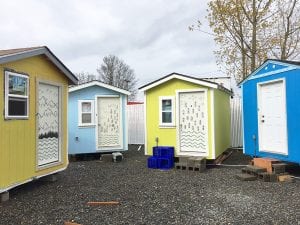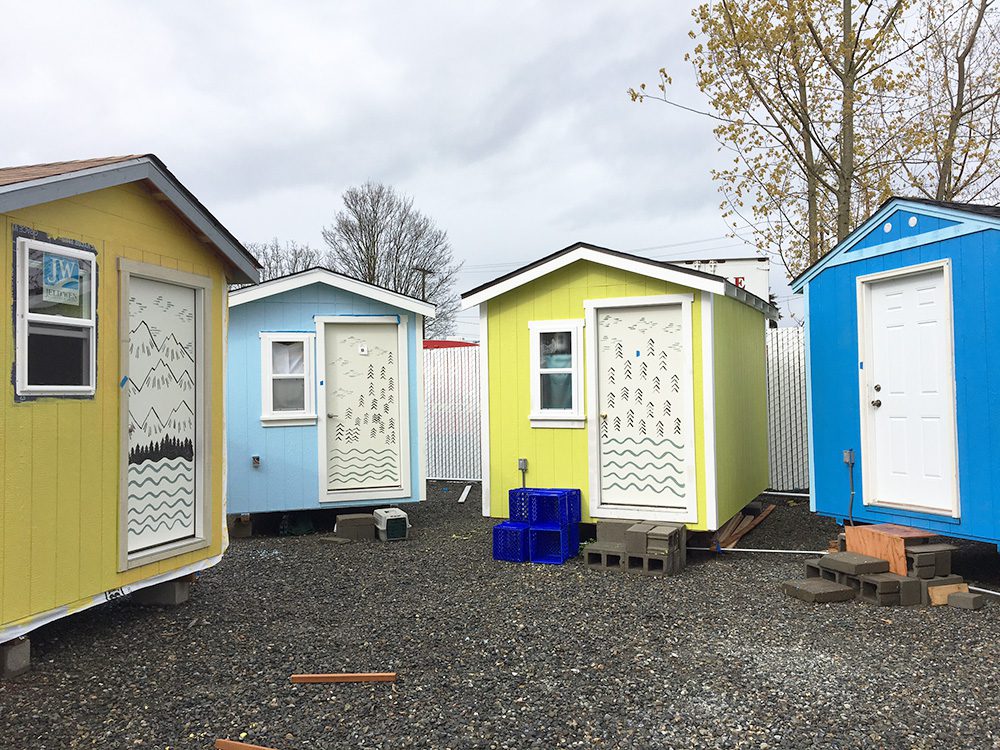
A group of tiny houses. Photo courtesy of the Low Income Housing Institute
Seattle is known for having mild winters, with average temperatures hovering around 45 degrees. Nevertheless, in December 2016, the King County Medical Examiner documented that four homeless people had died from hypothermia. Since January of this year, 37 homeless men and women have died living on the streets.
In 2016, at least 91 homeless men and women have died due to exposure, poor health, violence, drug overdoses, suicides, and being struck by cars. More people die as a result of their homelessness than are murdered in Seattle, on average.
Seattle has the third largest homeless population after New York and Los Angeles. The 2017 point-in-time count tallied more than 8,522 homeless men, women, and children living on the streets, in shelters, or in transitional housing. There were 3,857 unsheltered homeless people living on the streets, under roadways, or in vehicles—an increase of 31 percent from 2016. Shelters are full, low-income neighborhoods are rapidly gentrifying, and Seattle is outpacing other major cities in the percentage increase in market rents.
In 2015, the Seattle City Council—after seven years of advocacy from housing activists—unanimously passed an ordinance permitting up to three tent encampments or tiny house villages on city-owned or private property. In 2017, three new ones were also permitted and funded by the city.
Even though the Low Income Housing Institute (LIHI) is primarily known for developing low-income, multi-family rental housing (we own and operate over 2,000 apartments and have over 500 units in our pipeline), we decided to undertake tiny houses as a quick and effective way to respond to the homelessness crisis.
We’ve worked in partnership with SHARE and Nickelsville to establish five tiny house villages and one tent encampment, located in neighborhoods throughout Seattle. Five are city-sanctioned and one is church sponsored. SHARE and Nickelsville are responsible for day-to-day operations and the creation of self-managed communities of homeless people. Each adult resident agrees to a code of conduct and contributes to the community with work hours and chores. LIHI develops the sites, oversees finances, handles construction of the tiny houses, and provides case management and other supportive services to move residents into long-term housing and employment.
The Tiny House Village concept was developed as an innovative crisis response to homelessness by moving people into tiny houses instead of tents. Being able to live in an insulated or heated tiny house instead of a tent is a huge improvement for families and individuals experiencing homelessness.
Each tiny house costs $2,500 in materials and is 8 feet by 12 feet in area, about the size of a small bedroom. A couple or small family can fit in one. A large family can live in two tiny houses side by side. Local high schools, community colleges, and carpentry apprenticeship programs, tribes, businesses, church groups, and community members volunteer to build the easy-to-construct dwellings, and we receive donations of materials and funds from individuals, businesses, and foundations. The homes have electricity, heat, ventilation, insulation, windows, and, crucially, a lockable door. One of the main barriers homeless people face in stabilizing their lives is having a secure place for their belongings and documents.
How is it possible for tiny houses to be built so quickly given Seattle’s lengthy process for land-use and building-permit approvals? Tiny houses that are under 120 square feet are not considered dwelling units under the International Building Code. They can also be built in a few days by volunteers. This may feel like guerrilla housing, but a legal method has been established by the city of Seattle.
While each tiny house village has a somewhat different design, each has a common shared kitchen, a dining and community space, bathrooms, showers, a security booth at the entrance, and a donation hut. The villages provide a safe place to live for homeless individuals and families and the houses are all safe and sturdy structures.
The villages have proved to be incredibly successful. Kitty DeBerry, a resident, believes that the tiny houses are a good alternative for people experiencing homelessness. “Housing, four solid walls and a door that can close out the world; this is an essential need for a person’s sense of safety, security, and stability. The recent movement seen here in Washington and throughout the nation of supplying homeless populations with small housing units in long-term communities has shone a large ray of hope upon a population that can use all the hope it can find.”
We now have nearly two year’s experience with five city-sanctioned sites. The sites accommodate about 400 people, including children, at any one time. Hundreds of people have been helped short term as they passed through and stayed for a night or a week and successfully moved on. Last year was a watershed with positive outcomes. In 2016, LIHI case managers moved 157 people into housing, assisted 103 people obtain employment, and helped 30 people reunite with relatives or friends.
The city ordinance mandates there be a Community Advisory Committee (CAC) comprised of neighbors, businesses, community councils, and church groups who monitor progress, give feedback, and lend support to each village. Neighborhood residents in Ballard, Interbay, Georgetown, and Othello have embraced their new neighbors and are generously supporting residents with donations of building materials, clothing, blankets, food, books and toys for children, hygiene supplies, and other necessities.
Any time a new multi-family apartment building is planned to provide homeless housing, it takes three to four years to get through land assembly, financing, design, building permits and construction. We know that building more low-income housing is the real solution—but with thousands of vulnerable families and individuals on the streets today, tiny houses are a viable, low-cost, and dignified solution. And they save lives.






This is a very interesting initiative “Tiny Houses” I am not sure how something like that would work in New England with the cold winters but it definitely beats putting families in hotels..
With ample wind breakers, i.e trees, walls or etc., in addition to sufficient installation in ceilings and walls, they should prove worthy.
In my experience, Tiny Homes are a great initiative when facing high barriers to obtaining additional shelter beds in big cities like Seattle and LA, however, it does not seem like a great fit for communities with lower barriers to shelter bed development. Tiny Homes require money, energy, and political capital that could better be used on interventions that are already proven to effectively end homelessness like Rapid Rehousing and Permanent Supportive Housing (even combination Transitional Housing with Rapid Rehousing seems far more effective). Tiny homes are really just an expansion of shelter, not even qualifying as a dwelling, and may lengthen homelessness if the community lacks these other proven interventions. When developing an effective homeless system it is not a matter of choosing between good and bad interventions, but between good and better/best. RRH and PSH, and affordable housing development are simply better uses of finite resources for the vast majority of communities. Don’t get too swept up in the hype of Tiny Homes to look at all your options and to utilize and improve current evidence-based practices already available.
Rapid Rehousing may be a good option in areas where housing cost is relatively low. However, in high housing cost areas such as Washington DC, the rapid rehousing model does not work well if it all.
For instance, the rapid rehousing model is based upon the assumption that subsidies would provide support for low-income person or family until such time as that family can increase their income to be able to pay the rent without the subsidy. In a high housing cost area, to expect a very low income individual/family to increase their income within a period of 12 months or so to pay unsubsidized rent is neither practical and in most cases not possible.
For instance, in Washington DC a two-bedroom apartment would rent for around $1,700 per month. With the HUD based assumption that 30% of income is a reasonable amount to pay for housing, to support the two bedroom apartment would require an annual income of $68,000. For a family of two the federal poverty level is $16,240. Assuming that a family living at poverty level needed to increase their income by $51,670 per year is virtually impossible.
Moreover, rapid rehousing maybe a good model in some areas but in high housing cost areas it is very likely not a good option.
Looking into the research and the numbers is important before reaching conclusions about the effectiveness of a particular model.
It’s entirely reasonable to expect that many homeless people will be able to increase their income in a period of a few months, once they have secured housing. You’re right that this doesn’t work for everyone, but Rapid Re-Housing isn’t designed to work for everyone.
As for D.C.–yes it’s really expensive, and yes there is a serious shortage of affordable housing, and yes I’m sure there’s a serious wage/rent gap in the area like many expensive cities. However, I think you’re conflating federal poverty level with AMI. It’s a little silly to assume all previously homeless 2-person households in D.C. can only make $16,240, or would never be able to get jobs to afford fair market rent on their own.
You’re right that making these programs work in tight rental markets is very difficult, but I don’t think they were ever designed to be a “one-size fits all.” Not one-size-fits-all for every homeless client, and not one-size-fits-all for every city.
I believe that one key feature needed to allow the village of tiny houses to evolve from a shelter to a neighborhood is to give at the least the possibility of permanent tenure to the occupants. Tenure over the home and over some area of “Yard” around the home. In California, one option may be the new Permanent Real Estate Trust form. This, because if people know they have such tenure, it is much more likely they will begin to invest their own genius/taste into the tiny home and into the tiny yard. These “rights” should be tempered by appropriate design regulations, such as to protect solar access (“No you can not plant a redwood tree next to your house”), access, quiet hours, health and safety. But these regulations should err on the side of loose because that space allows people to let their vision out. (and paint the front door yellow or even green and purple). And it is individual vision that makes a place real, not architect-real. This is the way to create homes and a village people can love. If it is loved it will be much better cared for. And if it is cared for with loving care, it will glow and so will its residents. And the surroundings.